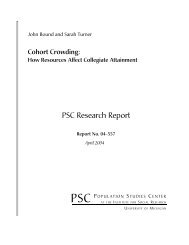Health Status among Older Immigrants in the United States
Health Status among Older Immigrants in the United States
Health Status among Older Immigrants in the United States
Create successful ePaper yourself
Turn your PDF publications into a flip-book with our unique Google optimized e-Paper software.
Immigrant-Native <strong>Health</strong> Disparities, With<strong>in</strong> Detailed Racial/Ethnic GroupCompar<strong>in</strong>g immigrants and natives with<strong>in</strong> each detailed racial/ethnic group (Table 3), we f<strong>in</strong>d that for all groups(except Puerto Ricans), immigrants have <strong>the</strong> same or lower prevalence of activity limitation than natives, andimmigrants are less likely to be obese than natives. However, for all groups (except blacks), immigrants are morelikely to be <strong>in</strong> fair or poor health. For each health outcome, <strong>the</strong> immigrant-native gap ranges from 0% to 4% <strong>in</strong> mostgroups. However, <strong>the</strong> immigrant-native disparities are particularly large for Puerto Ricans and blacks. Among PuertoRicans, <strong>the</strong>re is an 18 percentage po<strong>in</strong>t difference <strong>in</strong> favor of <strong>the</strong> ma<strong>in</strong>land-born for self-reported general health and a13 percentage po<strong>in</strong>t difference <strong>in</strong> favor of <strong>the</strong> ma<strong>in</strong>land-born for activity limitation. Among blacks, <strong>the</strong>re is a 15 anda 13 percentage po<strong>in</strong>t difference <strong>in</strong> favor of immigrants for general health and activity limitation, respectively. Thegap between black immigrants and natives is also large for obesity (9 percentage po<strong>in</strong>ts <strong>in</strong> favor of immigrants).We fur<strong>the</strong>r exam<strong>in</strong>e health disparities by detailed racial/ethnic group with multivariate logistic regressions foreach health outcome <strong>in</strong> Tables 4, 5, and 7. In addition to <strong>the</strong> coefficient estimates, <strong>the</strong> tables report statistical testsfor <strong>the</strong> difference between immigrants and natives with<strong>in</strong> <strong>the</strong> same racial/ethnic group, with a statistically significantdifference at <strong>the</strong> 0.05 level <strong>in</strong>dicated with a superscript “y.” The analyses reveal a persistent and significant gap <strong>in</strong>health between immigrant and native blacks on all three health outcomes. Black immigrants have <strong>the</strong> same or betterhealth than white natives, while black natives are disadvantaged regardless of controls for group differences <strong>in</strong>demographic, socio-economic, geographical and o<strong>the</strong>r factors. White immigrants have <strong>the</strong> same odds of be<strong>in</strong>g <strong>in</strong> fairor poor health but lower odds of hav<strong>in</strong>g an activity limitation or be<strong>in</strong>g obese relative to white natives. As with blacks,any observed group differences (or lack <strong>the</strong>reof) hold across all models. There is no significant difference <strong>in</strong> healthon any of <strong>the</strong> three outcomes between immigrants and natives <strong>among</strong> Asian groups, regardless of model controls,with <strong>the</strong> exception of O<strong>the</strong>r Asians (a heterogeneous group). In terms of obesity, O<strong>the</strong>r Asian immigrants have asignificant and persistent advantage <strong>in</strong> health relative to <strong>the</strong>ir U. S.-born counterparts.Among Puerto Ricans, <strong>the</strong>re is no significant difference <strong>in</strong> health between <strong>the</strong> island-born and <strong>the</strong> ma<strong>in</strong>land-born<strong>in</strong> terms of obesity. However, natives are less likely to have an activity limitation. This disparity <strong>in</strong> activity limitationis completely expla<strong>in</strong>ed by group differences <strong>in</strong> education or <strong>in</strong>come. Natives are also less likely to report be<strong>in</strong>g <strong>in</strong>fair or poor health, a disparity expla<strong>in</strong>ed solely by educational differences between <strong>the</strong> two groups.Net of demographic factors, Mexican immigrants and natives are not significantly different from one ano<strong>the</strong>r <strong>in</strong>terms of obesity, activity limitation or general health (Tables 4, 5 and 7, model 1). However, while parity holds trueacross subsequent models for obesity, disparities <strong>in</strong> general health and activity limitation become evident once socioeconomicfactors are controlled. <strong>Immigrants</strong> are less likely to be <strong>in</strong> poor health only <strong>in</strong> models where education iscontrolled. They are also less likely to have an activity limitation when ei<strong>the</strong>r education or <strong>in</strong>come is controlled.For all three health outcomes, O<strong>the</strong>r Hispanic immigrants and natives are <strong>in</strong>itially at par, net of demographicfactors. However, <strong>in</strong> terms of activity limitation and obesity, a gap <strong>in</strong> health - <strong>in</strong> favor of immigrants - becomesapparent once ei<strong>the</strong>r education or <strong>in</strong>come is controlled. A significant difference, aga<strong>in</strong> <strong>in</strong> favor of immigrants, isobserved for general health status only when <strong>in</strong>come, education and geography are simultaneously controlled. Thisf<strong>in</strong>d<strong>in</strong>g on general health mirrors that for Cuban immigrants and natives, who are o<strong>the</strong>rwise at par - across allmodels - on obesity and activity limitation outcomes. O<strong>the</strong>r Race immigrants and natives have no difference <strong>in</strong>general health and activity limitation, regardless of controls. However, O<strong>the</strong>r Race immigrants are less likely to beobese than natives once ei<strong>the</strong>r education or <strong>in</strong>come is controlled.DISCUSSIONThe rise <strong>in</strong> immigration and <strong>the</strong> <strong>in</strong>crease <strong>in</strong> health care costs have focused greater attention on health careutilization, health <strong>in</strong>surance coverage, and health status of immigrants. This paper has exam<strong>in</strong>ed <strong>the</strong> latter by pa<strong>in</strong>t<strong>in</strong>ga broad picture of <strong>the</strong> health status of immigrants born <strong>in</strong> various countries, compar<strong>in</strong>g <strong>the</strong>ir situation withimmigrants born <strong>in</strong> o<strong>the</strong>r countries and U. S.-born persons of similar racial and ethnic backgrounds. As expected7















